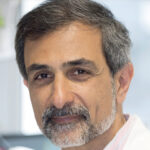Link to Pubmed [PMID] – 26237517
Nat. Biotechnol. 2015 Sep;33(9):962-9
During embryonic development, skeletal muscles arise from somites, which derive from the presomitic mesoderm (PSM). Using PSM development as a guide, we establish conditions for the differentiation of monolayer cultures of mouse embryonic stem (ES) cells into PSM-like cells without the introduction of transgenes or cell sorting. We show that primary and secondary skeletal myogenesis can be recapitulated in vitro from the PSM-like cells, providing an efficient, serum-free protocol for the generation of striated, contractile fibers from mouse and human pluripotent cells. The mouse ES cells also differentiate into Pax7(+) cells with satellite cell characteristics, including the ability to form dystrophin(+) fibers when grafted into muscles of dystrophin-deficient mdx mice, a model of Duchenne muscular dystrophy (DMD). Fibers derived from ES cells of mdx mice exhibit an abnormal branched phenotype resembling that described in vivo, thus providing an attractive model to study the origin of the pathological defects associated with DMD.

